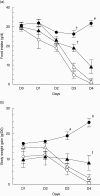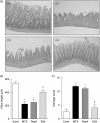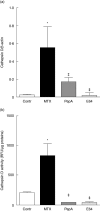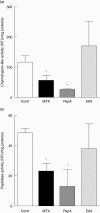Beneficial effects of cathepsin inhibition to prevent chemotherapy-induced intestinal mucositis
- PMID: 20731673
- PMCID: PMC2996597
- DOI: 10.1111/j.1365-2249.2010.04220.x
Beneficial effects of cathepsin inhibition to prevent chemotherapy-induced intestinal mucositis
Abstract
One of the main secondary toxic side effects of anti-mitotic agents used to treat cancer patients is intestinal mucositis. Previous data showed that cathepsin D activity, contributing to the proteolytic lysosomal pathway, is up-regulated during intestinal mucositis in rats. At the same time, cathepsin inhibition limits intestinal damage in animal models of inflammatory bowel diseases. The aim of this study was to evaluate the effects of cathepsin inhibition on methotrexate-induced mucositis in rats. Male Sprague-Dawley rats received saline solution subcutaneously as the control group or 2·5 mg/kg of methotrexate for 3 days (D0-D2). From D0 to D3 methotrexate-treated rats also received intraperitoneal injections of pepstatin A, a specific inhibitor of cathepsin D or E64, an inhibitor of cathepsins B, H and L, or vehicle. Rats were euthanized at D4 and jejunal samples were collected. Body weight and food intake were partially preserved in rats receiving E64 compared with rats receiving vehicle or pepstatin A. Cathepsin D activity, used as a marker of lysosomal pathway, was reduced both in E64 and pepstatin-treated rats. However, villus atrophy and intestinal damage observed in methotrexate-treated rats were restored in rats receiving E64 but not in rats receiving pepstatin A. The intramucosal concentration of proinflammatory cytokines, interleukin-1β and cytokine-induced neutrophil chemoattractant (CINC)-2, was markedly increased in methotrexate-treated rats receiving vehicle or pepstatin A but not after E64 treatment. In conclusion, a large broad inhibition of cathepsins could represent a new potential target to limit the severity of chemotherapy-induced mucositis as opposed to the inhibition of cathepsin D alone.
© 2010 British Society for Immunology.
Figures





Similar articles
-
Methotrexate induces intestinal mucositis and alters gut protein metabolism independently of reduced food intake.Am J Physiol Endocrinol Metab. 2009 Jan;296(1):E182-90. doi: 10.1152/ajpendo.90459.2008. Epub 2008 Nov 4. Am J Physiol Endocrinol Metab. 2009. PMID: 18984853
-
Chemotherapy-induced mucositis is associated with changes in proteolytic pathways.Exp Biol Med (Maywood). 2008 Feb;233(2):219-28. doi: 10.3181/0702-RM-49. Exp Biol Med (Maywood). 2008. PMID: 18222977
-
In a methotrexate-induced model of intestinal mucositis, olmesartan reduced inflammation and induced enteropathy characterized by severe diarrhea, weight loss, and reduced sucrose activity.Biol Pharm Bull. 2015;38(5):746-52. doi: 10.1248/bpb.b14-00847. Biol Pharm Bull. 2015. PMID: 25947920
-
Interaction between host cells and microbes in chemotherapy-induced mucositis.Nutrients. 2013 Apr 29;5(5):1488-99. doi: 10.3390/nu5051488. Nutrients. 2013. PMID: 23628721 Free PMC article. Review.
-
Dark Agouti rat model of chemotherapy-induced mucositis: establishment and current state of the art.Exp Biol Med (Maywood). 2015 Jun;240(6):725-41. doi: 10.1177/1535370215581309. Epub 2015 May 12. Exp Biol Med (Maywood). 2015. PMID: 25966981 Free PMC article. Review.
Cited by
-
Cysteine cathepsin proteases: regulators of cancer progression and therapeutic response.Nat Rev Cancer. 2015 Dec;15(12):712-29. doi: 10.1038/nrc4027. Nat Rev Cancer. 2015. PMID: 26597527 Review.
-
Cynaroside ameliorates methotrexate-induced enteritis in rats through inhibiting NLRP3 inflammasome activation.Front Immunol. 2024 May 21;15:1405084. doi: 10.3389/fimmu.2024.1405084. eCollection 2024. Front Immunol. 2024. PMID: 38835771 Free PMC article.
-
High-intensity intermittent training ameliorates methotrexate-induced acute lung injury.BMC Pulm Med. 2024 Jan 20;24(1):45. doi: 10.1186/s12890-024-02853-w. BMC Pulm Med. 2024. PMID: 38245672 Free PMC article.
-
Effects of nimesulide on the small intestine mucositis induced by methotrexate in rats.Exp Anim. 2016 Nov 1;65(4):329-336. doi: 10.1538/expanim.15-0122. Epub 2016 Jun 21. Exp Anim. 2016. PMID: 27333839 Free PMC article. Clinical Trial.
-
Effect of lutein on methotrexate-induced oxidative lung damage in rats: a biochemical and histopathological assessment.Korean J Intern Med. 2019 Nov;34(6):1279-1286. doi: 10.3904/kjim.2018.145. Epub 2019 Sep 10. Korean J Intern Med. 2019. PMID: 31495083 Free PMC article.
References
-
- Logan RM, Gibson RJ, Bowen JM, Stringer AM, Sonis ST, Keefe DM. Characterisation of mucosal changes in the alimentary tract following administration of irinotecan: implications for the pathobiology of mucositis. Cancer Chemother Pharmacol. 2008;62:33–41. - PubMed
-
- Keefe DM, Cummins AG, Dale BM, Kotasek D, Robb TA, Sage RE. Effect of high-dose chemotherapy on intestinal permeability in humans. Clin Sci (Lond) 1997;92:385–9. - PubMed
-
- Logan RM, Stringer AM, Bowen JM, Gibson RJ, Sonis ST, Keefe DM. Serum levels of NFkappaB and pro-inflammatory cytokines following administration of mucotoxic drugs. Cancer Biol Ther. 2008;7:1139–45. - PubMed
-
- Carneiro-Filho BA, Lima IP, Araujo DH, et al. Intestinal barrier function and secretion in methotrexate-induced rat intestinal mucositis. Dig Dis Sci. 2004;49:65–72. - PubMed
Publication types
MeSH terms
Substances
LinkOut - more resources
Full Text Sources

